It’s Carnival in the NL (and Abroad!): See How Different Countries Celebrate
It’s Carnival in the NL (and Abroad!): See How Different Countries Celebrate
It’s Carnival in the NL (and Abroad!): See How Different Countries Celebrate
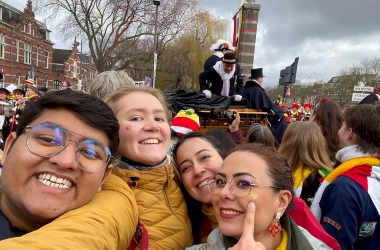
Traditional Festivals Include Parades, Costumes, Dance, Music and Drinks
It’s that time of the year again! Traditionally celebrated in the Netherlands for many centuries, Carnival is about to hit the streets of various cities in the country’s southern provinces of North Brabant and Limburg. In 2024, the festivities will take place from 11 to 13 February in cities such as Maastricht, Den Bosch, Tilburg, Eindhoven, Venlo and Breda, among others.
During these events, the streets are filled with colourful crowds, many of them wearing costumes. There is plenty of drinking, singing and dancing to traditional Carnival songs, as well as other attractions such as parades and concerts.
Stemming from ancient European festivals such as the Roman Saturnalia and the celebrations of Germanic tribes, Carnival was later incorporated into Christian tradition, to mark the start of the fasting season of Lent. In the Netherlands, the official start of the Carnival season is on 11 November, when people gather on the main streets of their cities to elect the Carnival Prince. Later, the main events take place in February or March, according to each year’s specific date. Each Dutch city has its own tradition, including unique costumes and items worn by party-goers.
In addition to the Netherlands, Carnival is celebrated in many European countries and other parts of the world. We have asked some members of the Wittenborg family to share their Carnival experiences with us.
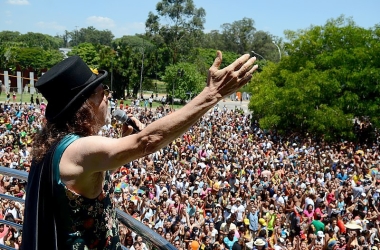
Celebrating Carnival in Brazil
Wittenborg Associate Professor Vanessa de Oliveira Menezes, originally from Brazil, was taken by her parents to her first Carnival parties when she was about four years old. At the time, Vanessa lived in the city of Umuarama, located in the south of the country, where people mainly celebrated Carnival by attending private balls held at clubs.
At these events, people would sing ‘marchinhas’ (traditional Brazilian Carnival songs), dance and wear costumes. “My family has always enjoyed Carnival and music in general, and this was an occasion to have a good time together. When I was a child, the most fun aspect of Carnival for me were the costumes. I had a lot of fun planning and creating the costumes I was going to wear, and I attended Carnivals dressed as a pirate and a ballerina, among other characters,” she recalls.
Vanessa’s enthusiasm for Carnival lasted into her teenage years, when she started travelling by bus with her friends to attend Carnivals in the coastal town of Guaratuba, also in her native state of Paraná.
“By then, I wanted something more exciting than the Carnival balls I had attended as a child, so I started going to the street Carnivals of the coast. Even though Guaratuba is a small beach town, it would be packed with people. We would party all night long and sleep during the day, so there was no time for going to the beach. I was always enthusiastic about Carnival, being the first person to arrive at the party and the last to leave. I would attend every day of the festivities,” she says.
Vanessa highlights that, in Brazil, one of the main features of street Carnivals is the ‘trio elétrico’ (electric trio). This is a kind of truck equipped with a high-power sound system and a stage for music performances on top, playing for the crowd as it drives through the cities. In addition to the traditional marchinhas, the ‘trios elétricos’ play other types of songs, such as the more pop-oriented axé music, originally from the northeast of Brazil.
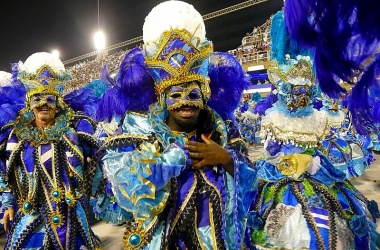
“Carnival is a significant part of Brazil’s cultural identity; Brazilians like partying and celebrating, and so they hold this big celebration in which people gather to have a good time, as well as take some days off from work. Although Carnival originally had a religious meaning, people don’t really think about that anymore,” she sums up.
Brazilian MBM student Beatriz de Rosa Soares, originally from São Paulo, points out that there are several ways to celebrate Carnival in the country’s different regions. While some people prefer to join the street blocks, others will rather watch the big parades held at the ‘sambadromes’ in Rio de Janeiro and São Paulo. In these events, which are broadcast nationally, samba schools compete by performing their theme song of the year, accompanied by large-scale floats and hundreds (sometimes thousands) of members of the groups wearing elaborate costumes.
Additionally, some cities like Olinda, Recife and Salvador have different types of music and dance, as well as their own folkloric characters who give a unique flavour to their Carnival celebrations.
“I have celebrated Carnival in various manners, but my favourite way to do it is to attend the pre-Carnival street blocks, which take place on January weekends. During Carnival itself, which is a four-day holiday in Brazil, from Saturday to Mardi Gras, I like travelling to my family’s country house with relatives and friends, in a group of about 30 people. This way, we can celebrate and have a good time together. I have also attended the big parades at the ‘sambadromes’, as a spectator, and I highly recommend that for people who would like to visit Brazil.”
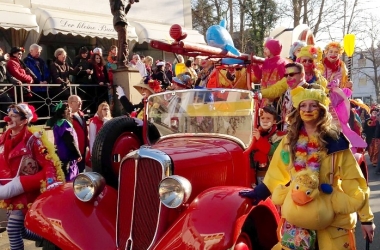
Germany
While living in Germany, Vanessa had the opportunity to attend the Cologne Carnival, which is the largest and most famous German event of this kind. For her, one of the most remarkable differences in relation to the Brazilian Carnival is the fact that, in Europe, the festivities take place during winter.
“It was 6°C and I was wearing two layers of clothing while partying on the street, something that I had never experienced in Brazil, where Carnival always takes place in summer,” she laughs.
The associate professor points out that while the Cologne Carnival features striking floats, these are not so much of a celebratory nature, but rather political or critical, addressing current themes with a touch of irony and dark humour. She notes that, in addition to the locals, the celebrations are attended by very large numbers of tourists, and people wear costumes of different types, from care bears to tin soldiers.
“Cologne has its own Carnival songs, which are really connected to the city’s folklore. The people know all those songs by heart, and they sing them with enthusiasm. There is also lots of drinking, which is normal in German celebrations. My overall experience there was very good.”
Another popular German Carnival is the one that takes place in Munich, where Wittenborg has a study location.
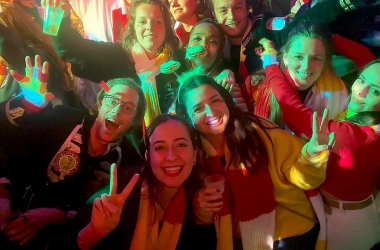
Den Bosch
In the Netherlands, both Vanessa and Beatriz have had the opportunity to experience Den Bosch’s Carnival, when the city gets informally renamed ‘Oeteldonk’ (Frog Hill).
Beatriz comments that the city has its own parade, adding that party-goers wear a traditional kind of clothing which is very characteristic. “Every Dutch city has its own kind of Carnival clothing, and it is no different in Den Bosch. There, people wear black or red blazers, to where they pin brooches and pins that allude to memories of past Carnivals. The main colours worn by people during the celebrations are red, white and yellow.”
For Vanessa, attending Carnival in Den Bosch was an accidental – and fun – experience. “I had had an appointment in another city and, when changing trains in Utrecht, I saw lots of people wearing red and yellow scarves, which made me curious. I noticed that quite a few of them wore top hats and blazers, and many people were also wearing pins with the image of a frog. At first, I thought it was a crowd of football supporters, but someone told me that it was Carnival, which I found strange, because it was 11 November. But later I found out that that is the date which officially launches the Carnival season in the Netherlands.”
Driven by her curiosity, she decided to join the crowd and see what that fest was like. “The city was completely packed, and it was impressive. Its centre was closed, including all shops, and there were lots of people on the streets, all celebrating and dancing to traditional Dutch Carnival songs. They were also drinking a lot, and the overall atmosphere reminded me a little bit of the Cologne Carnival. However, one big difference is that there were no floats, because this was the November event and the parade takes place in the second part of Carnival, at the start of the year.”
This year, the Den Bosch Carnival will have its official opening on Sunday, 11 February, at 11:11, when the event's ‘monarch’ will make an appearance at Den Bosch Central Station. Carnival Monday, celebrated on 12 February, is the high point of the Den Bosch Carnival, with the parade kicking off at 12:33, at Van Grobbendoncklaan. There will be activities taking place until Tuesday, 13 February.
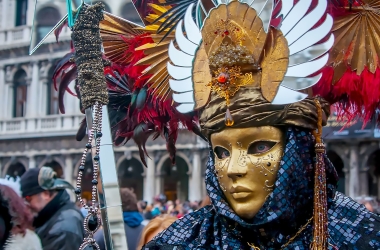
Italy
Another country where Carnival is popular is Italy, and the most famous Italian Carnivals take place in Venice and Viareggio. Venice is well-known for its masquerade balls, during which people celebrate while wearing traditional masks and costumes. In the past, the streets of the city were filled with anonymous masked people, aiming to remove social differences.
The Viareggio Carnival, in turn, is famous for its parades featuring giant papier-mâché floats, night parties, fireworks, theatre plays, food events and big sports competitions such as the Viareggio football tournament 'Coppa Carnevale'.
Wittenborg Admissions Administrator Allegra Zazzaro, originally from Milan, underlines that an important feature of the Italian Carnival is each region’s typical food, including desserts like chiacchere, castagnole and le graffe.
Allegra attended Carnival celebrations during kindergarten and elementary school. For her, the most exciting aspects of those events were wearing funny costumes and celebrating with friends.
“The parties were lots of fun! When the weather was nice, people would mostly celebrate outside, going around the city wearing costumes and throwing paper confetti in the air. Our costumes would represent cartoon characters, animals and other figures. We would also eat le chiacchere, a traditional Carnival dessert. While growing up, I used to eat out with friends after class, the day before the holidays were starting, and celebrate with family and friends during the Carnival days,” she recalls.
WUP 09/02/2024
by Ulisses Sawczuk
1713 words